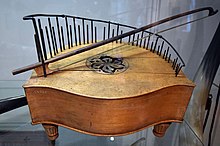Nail fiddle

A nail violin is an idiophonic musical instrument that has a wooden resonance body and many iron or steel pins arranged in a circular arc. This instrument was played with a violin bow , making it to the rubbing rod play counts.
sound
The sound of the instrument is relatively fine, but nevertheless penetrating. The sound most closely resembles that of a violin flageolet .
history
The nail violin was invented by Johann Wilde in 1740. It was triggered by a sound when he brushed a nail while hanging his violin bow on the wall. The main manufacturing countries until their temporary disappearance in the middle of the 19th century were Germany and Sweden.
The oldest nail violin was probably one with only nine pens, which has been preserved in the collection of the Eisenach Bachhaus . Typically around 37 pens were used - New York even had one with 66 pens. The sound box is usually semicircular to full-circle. However, it is difficult to prove that the instrument really looked like that. There weren't many specimens, just one in the Nordiska museet , Sweden, from 1792.
There was also a type that had 15 to 16 sympathetically resonating strings, mostly in addition to 49 pins. The development of this instrument around 1780 is attributed to the Viennese artist Senal. It was called the violino harmonico or violino harmonica and was performed on concert tours in Germany. The original stringless shape was refreshed in 1912 as a duolon , with a tuning bridge on the clip-like sound pins. Several new experimental developments emerged in the 20th century.
Names
The nail violin is known by many names. In Germany, these include needle violin, nail game, pen game, pin harmonica, nail harmonica, American harmonica, American violin, Russian steel fiddle or iron violin . In France this corresponds to the violin de fer, harmonie à clous de fer in English nail violin and in Swedish jernviolin and spikharmonika .
Other instruments
In 1888 an instrument was created that worked on the same principle, but had a keyboard. It was called the Aliquot String Flute by its inventor, Ph. J. Brambach . Here the pens were lifted up by pressing the keyboard and marked with a violin bow.
literature
- E. Heron-Allen, Hugh Davies: Nail violin. In: Laurence Libin (Ed.): The Grove Dictionary of Musical Instruments . Vol. 3, Oxford University Press, Oxford / New York 2014, pp. 566f
- Curt Sachs : Handbook of musical instruments . Breitkopf and Härtel, Wiesbaden 1979, ISBN 3-7651-0051-X , p. 66–68 (4th, reprographed reprint of the 2nd edition, Leipzig 1930).
Web links
- Complete works for nail violin (Henry Schneider)
- Nail violin in the Center for Performance History, London ( Memento from March 9, 2015 in the Internet Archive )